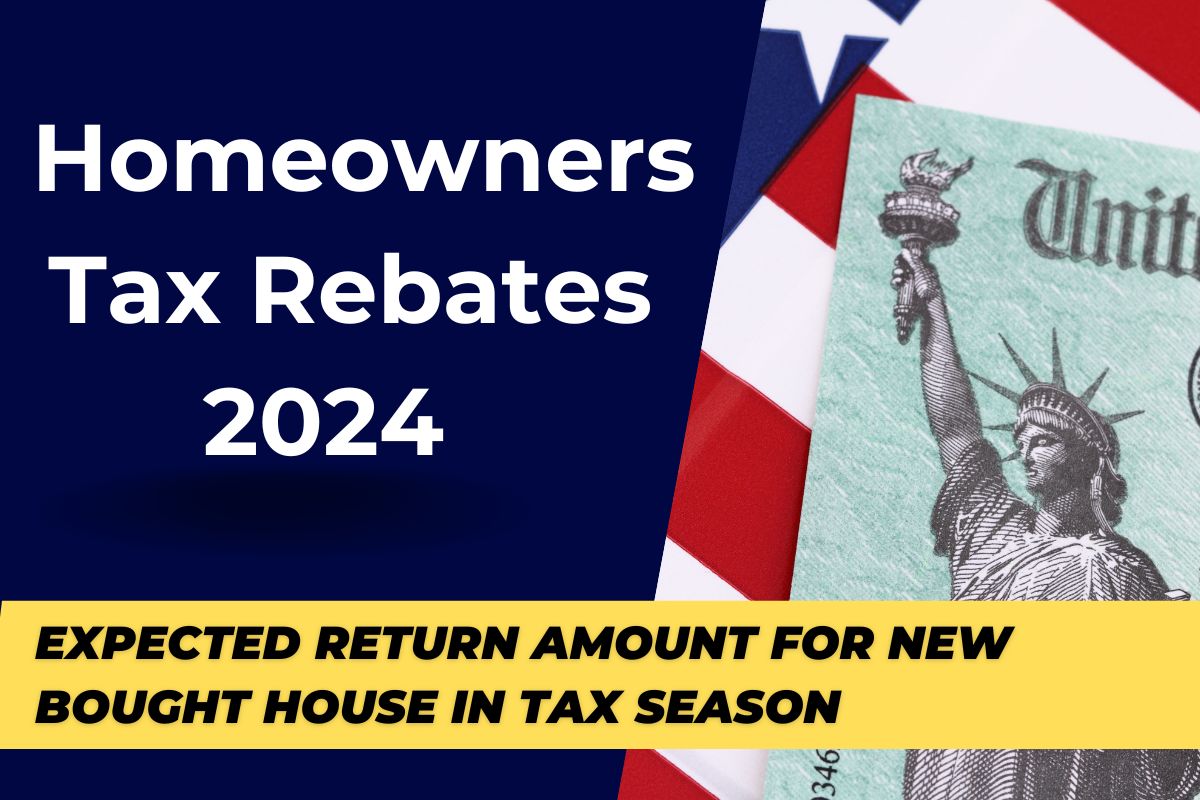The decision of purchasing a home represents not only a financial milestone but also unlocks opportunities for substantial tax advantages. As the tax season unfolds, property owners throughout the United States eagerly await Tax Rebates for Homeowners in 2024.
Although direct rebates for homeowners are unavailable, but the U.S. tax code provides a variety of options for homeowners, including deductions on mortgage interest payments and credits for home improvements, significantly reducing their overall tax liability. In this article, we will delve into the various deductions and credits, offering insights to maximize tax returns for new homeowners.
Tax Rebates for Homeowners in 2024
Tax rebates for homeowners in the USA can take various forms, offering incentives and deductions aimed at reducing the overall tax burden. By leveraging these deductions and credits, homeowners effectively reduce their taxable income, allowing them to retain more of their hard-earned money.
There are some of the efficient tax breaks options available for tax rebates for homeowners which they can use:
- Mortgage Interest Deduction (MID): When you pay interest on your mortgages, the MID permits them to deduct that amount from taxable income. Essentially, it’s like receiving a tax discount. This deduction proves especially valuable for those with high mortgage payments.
- Property Tax Deduction: Although owning a home means giving property tax payments, the positive news is that homeowners can deduct these property taxes paid on their primary residences.
- Energy-Efficient Upgrades: If you’ve implemented energy-saving enhancements in your home—such as installing solar panels or energy-efficient windows—you may qualify for tax credits. These credits directly reduce the tax liability.
- Home Office Deduction: If you use part of your home exclusively for business purposes (such as freelancing or self-employment), you can claim a home office deduction. This helps offload some of the costs associated with running a business from home.

Overview of tax rebates for Homeowners in USA
| Name | Tax rebates for homeowners |
| Country of Origin | USA |
| Applicable State | All states of USA |
| Regulating Body | IRS |
| Year | 2024 |
| Category | Financial Aid |
| Objective | Provide tax credits to the homeowners. |
| Applicable persons | New and existing homeowners. |
| Age Limit | 19+ years |
| Expected Credit Amount up to | $13,850 (single filers)
$27,700 (joint filers) $20,800 (heads of household or married filing separately.) |
| Payment Mode | Online (Direct Deposit) |
| Payment Duration | One time |
| New Payment Starting Month | April 2024 (expected) |
| Website | https://www.irs.gov/ |
Eligibility criteria for tax rebates for homeowners in 2024
Following are the basic eligibility criteria claim tax rebates for homeowners:
- Residency: The home must be your primary residence and must be located within the United States.
- Homeownership: You must be the legal owner and occupant of the residence.
- Tax Filing: You need to file a tax return and itemize deductions instead of taking the standard deduction.
- Documentation: Keep receipts or relevant documents proving your expenses related to the property (mortgage interest, property taxes, PMI payments, etc.)
For the various tax break options, some more criteria get added to the list:
- Mortgage Interest Deduction (MID): The mortgage must be a secured debt from an authorized bank or organizations on a qualified home in which you have an ownership interest.
- Property Tax Deduction: It can be only applied on properties such as, primary home, vacation stays, unused land etc.
- Energy-Efficient Upgrades: It includes home energy audits, upgrades done on energy savings appliances like solar panels, rainwater harvesters etc during the tax year.
- Home Office Deduction: You must be using a part of your home for conducting your business and calculate percentage of your dedicated business activities to deduct expenses such as mortgage interest, insurance, utilities, repairs, and depreciation for that area.
How much tax rebates homeowners can get during this tax season?
When filing your tax return, choose between the standard deduction and itemizing. Single filers receive a $13,850 home tax deduction. Joint filers can get up to $27,700 (for joint filers) or $20,800 (for heads of household or married filing separately). To benefit from homeowner tax and itemised deductions, use Form 1040 Schedule A.
You may claim some more rebates from the tax breaks through:
- Mortgage Interest Deduction (MID): You can deduct home mortgage interest on the first $750,000 of debt ($375,000 if married filing separately). If you are deducting mortgage interest from debt occurring before December 16, 2017, higher limitations apply.
- Property Tax Deduction: You can deduct up to $10,000 ($5,000 if married filing separately) for a combination of property taxes and either state and local income taxes or sales taxes.
- Energy-Efficient Upgrades: If you make qualified energy-efficient improvements to your home after January 1, 2023, you may qualify for a tax credit of up to $3,200 or 30%.
- Home Office Deduction: The rebate for the home office deduction depends on your business-related costs, such as utilities and square footage.
Tax Rebates for Homeowners 2024 Apply Process & Status Check
To apply for tax rebates for homeowners, gather necessary documents (such as mortgage interest statements, property tax bills, and PMI payment records) and file your tax returns on time. Opt for itemized deductions instead of the standard deduction to claim homeowner-related benefits.
To check your tax refund status, visit the IRS website’s “Where’s My Refund?” tool. Enter your Social Security Number (SSN), filing status, and the expected refund amount. You can expect to see the status within 24 hours after e-filing a current-year return, 3 or 4 days after e-filing a prior-year return, or 4 weeks after filing offline.
| Sass News Home | Visit Here |

Hello! I’m Kate Murray, a professional content writer with a knack for breathing life into words. I have been providing high-quality, research-driven, and SEO-optimized content for various online platforms. With a background in SEO and digital marketing, I specialize in turning complex information into engaging content that resonates with a wide audience.
